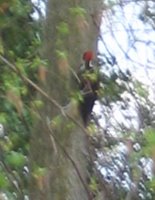Roosevelt Island occupies a special place in the Washington birding itinerary. It does not quite ranking with the big sites like Rock Creek Park, Kenilworth, or the Arboretum. But it has a wildness about it not seen in most other small D.C. parks, and it combines an array of habitats within a very small space. One can pass through tidal marsh, bottomland forest, and upland forest all within an hour's walk. The first thing that impressed me about the island this evening was its dryness. At left I have placed a photograph of a muddy patch this evening. That muddy patch is usually covered with standing water. The trail I followed to take that picture is usually impassable because of muddy conditions; today it was bone-dry.
The first thing that impressed me about the island this evening was its dryness. At left I have placed a photograph of a muddy patch this evening. That muddy patch is usually covered with standing water. The trail I followed to take that picture is usually impassable because of muddy conditions; today it was bone-dry.
At the end of the island and in the marsh, there were swarms of swallows. Almost all of these were northern rough-winged swallows, a species I had not seen since last July. They darted back and forth across the water in the typical swallow fashion, flying swiftly, then suddenly reversing course. At times, they seemed to stop in midair before changing direction. Among them were a few slightly smaller swallows with more deeply notched tails, white throats, and brown neck bands; these were bank swallows.
A few killdeer were in the marsh. While these are not entirely unexpected at Roosevelt Island, I usually do not see shorebirds (killdeer or otherwise) at this location. Wood ducks, both on the riverbank and in the marsh, were another pleasing sighting. Several hermit thrushes flocked around the Roosevelt Memorial near the entrance.
At right: blurry footage of a large, crested woodpecker.
Along my walk, I found a red-shouldered hawk nest. Or, perhaps it is better to say that the nesting red-shouldered hawk found me. As I passed by the nest, the proud parent starting calling vociferously. I stood off a bit where I was less conspicuous and watched through my binoculars as it shook its feathers and shifted position on the eggs. I will have to check back there to see if they hatch.
The pair that is nesting at Roosevelt Island is one of several breeding pairs in the District. Other pairs of breeding red-shouldered hawks have territories in Rock Creek Park, Kenilworth, and the National Arboretum. There may be another pair in the Catholic University area, and possibly another along the canal. While the species may be declining overall, it seems to be thriving in D.C.
SPECIES SEEN: 31
Double-crested Cormorant
Great Blue Heron
Canada Goose
Wood Duck
Mallard
American Black Duck
Red-shouldered Hawk
Killdeer
Rock Pigeon
Mourning Dove
Red-bellied Woodpecker
Downy Woodpecker
Northern Flicker
Pileated Woodpecker
Northern Rough-winged Swallow
Bank Swallow
Golden-crowned Kinglet
Carolina Wren
Northern Mockingbird
Hermit Thrush
American Robin
Carolina Chickadee
American Crow
European Starling
Song Sparrow
Swamp Sparrow
White-throated Sparrow
Dark-eyed Junco
Northern Cardinal
Red-winged Blackbird
Common Grackle



